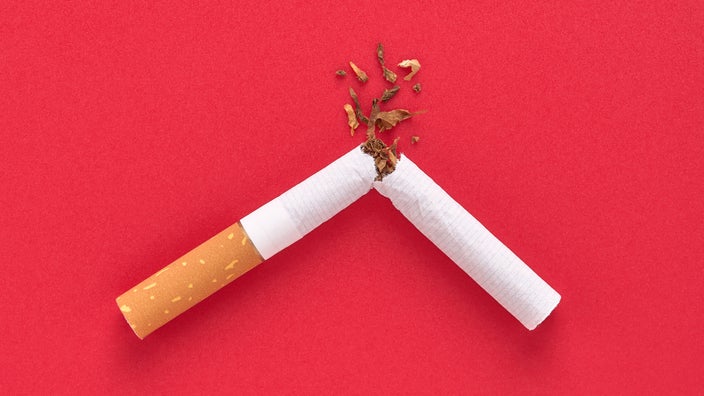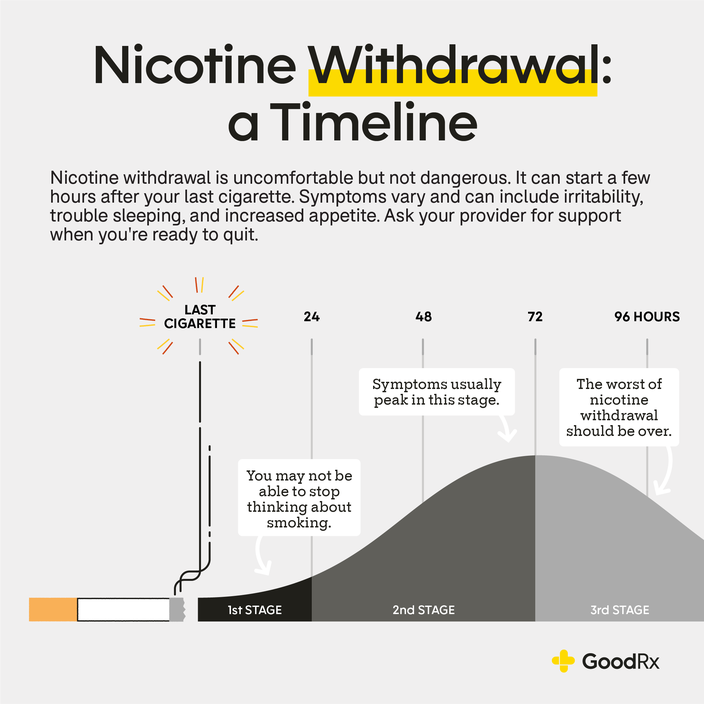
Nicotine Withdrawal: Symptoms, Timeline, and How to Cope
Key takeaways:
Nicotine withdrawal happens because nicotine is an addictive substance. Over time, the body and brain can become dependent on nicotine and crave it once you stop.
Nicotine withdrawal is uncomfortable, but it’s not deadly. Withdrawal symptoms usually peak within 3 days of quitting. They can start to improve after 1 week.
With smoking cessation tools, you can successfully manage nicotine withdrawal. It’s possible to quit smoking for good.
Access savings on related medications
Table of contents

Smoking is among the most harmful habits, and it’s one of the hardest habits to kick. Although you may want to quit smoking or other tobacco use, you might find it difficult to get through nicotine withdrawal. Nicotine withdrawal is the physical and mental symptoms that people have when they quit using tobacco.
Symptoms of nicotine withdrawal can be very uncomfortable. But the withdrawal process isn’t dangerous like it can be with other substances. It’s possible to successfully quit on your own. Let’s take a closer look at nicotine withdrawal symptoms and what you can expect when you quit smoking.

Nicotine withdrawal symptoms
The symptoms and severity of nicotine withdrawal vary from person to person. They usually depend on how much nicotine you’ve used and for how long. People who’ve used large amounts of nicotine over a long period of time are more likely to experience severe withdrawal symptoms.
During nicotine withdrawal, you may have both physical and mental symptoms, which can make quitting nicotine difficult.
Physical symptoms
Increased appetite is a common physical symptom of nicotine withdrawal. This may lead to weight gain.
Research shows that most people gain at least some weight after quitting smoking. And some people may develop weight-related conditions like a BMI over 30 or Type 2 diabetes. The average weight gain for people who quit smoking can be up to 10 lbs.
But the health benefits of quitting tobacco use outweigh the effects of gaining weight. There are also healthy and effective ways to manage your weight after you quit smoking.
Along with increased appetite and weight gain, other physical symptoms of nicotine withdrawal include:
Nausea and vomiting
Dizziness
Headaches
Constipation
Sore throat
Gas or diarrhea
Chest tightness
Dry mouth
Nasal drip
Tremors
Mental and behavioral symptoms
Other common symptoms of nicotine withdrawal include urges and cravings for nicotine. After quitting smoking, you’ll likely experience strong cravings to use nicotine again. These can be both physical and mental.
The physical discomforts of nicotine withdrawal can lead to cravings. But for some people, missing the ritual of smoking — taking the cigarette out, lighting it, and smoking it — can also cause cravings.
Nicotine withdrawal can also cause cognitive effects. People often report a slight increase in mental performance while using nicotine. It can make them feel mentally sharper. During withdrawal, you may have symptoms like trouble concentrating or remembering things.
Other common mental or behavioral symptoms of nicotine withdrawal include:
Feeling irritable, grouchy, or angry
Experiencing anxiety, or feeling jumpy and restless
Having trouble sleeping
Having nightmares
Not being able to feel pleasure
Feeling sensitive to pain
Fortunately, withdrawal symptoms get better with time. Symptoms usually peak with the first few days after you quit smoking. And they generally settle within several weeks.
What triggers nicotine withdrawal?
Nicotine is a very addictive substance. Most people who use nicotine regularly do so because they have an addiction. When people who are dependent on nicotine try to quit, they can have withdrawal symptoms.
Nicotine is addictive because it acts directly on receptors in your central nervous system and changes the chemistry in your brain. Using nicotine — whether by smoking, chewing, or inhaling — causes a release of endorphins. Endorphins are brain chemicals that lead to a rush of pleasure. This “high” from nicotine is much shorter than the one from other substances, but it can still lead to addiction.
Another reason why people have nicotine addictions is because of the way the body processes it. Nicotine is processed into the bloodstream rapidly. Its effects are usually felt within 10 seconds of inhaling it (if it’s being smoked). But the rewarding effects of nicotine also disappear quickly. This causes many people to use more soon after to keep up the high of nicotine.
What are the effects of nicotine?
Nicotine causes dopamine (another brain chemical) to flood the reward center in the brain. And the brain can become used to the high levels of dopamine. Over time, this leads to brain changes in areas that affect how you think, learn, and process stress.
When you use nicotine over a period of time, the brain starts to crave the feeling that nicotine brings. And brain changes from long-term use can lead to dependence on nicotine.
When you’re dependent on nicotine, you have withdrawal symptoms when you try to stop. You might commit to quitting nicotine — and then find yourself with physical and mental withdrawal a few hours after your last cigarette.
When do nicotine cravings stop?
Once you’ve decided to quit nicotine, you’ll experience nicotine cravings and other withdrawal symptoms in your own way and on your own timeline. Nicotine cravings can last for days or weeks after quitting.
Until your nicotine cravings stop, there are ways to help make them more manageable.
Some possible strategies include:
Avoiding situations and people that you associate with smoking
Staying busy when a craving hits
Considering medications that control cravings (as discussed below)
Talking yourself through the craving and reminding yourself why you’re quitting
Months or years after quitting nicotine, cravings still might pop up occasionally. This is especially common during stressful times or in situations when you used to smoke. Fortunately, cravings become less frequent and less intense with time.
How long do nicotine withdrawal symptoms last?
How long nicotine withdrawal symptoms last is different for each person. This depends a lot on how long and how much you’ve used it. Your individual metabolism and genetics also influence how long and how intense your symptoms will be. The good news is that the intense symptoms of withdrawal are not life-threatening and will pass within a few hours to days.
Nicotine withdrawal timeline
The exact timeline of nicotine withdrawal depends on many factors, like how long and how much you used it before you chose to stop, and genetics. Genetics may also influence how dependent you become on nicotine in the first place. Roughly 50% of your experience with withdrawal symptoms and how successful you are when choosing to stop nicotine may also come from genetics.
Many people go through nicotine withdrawal in these three basic stages.
First stage: 4 to 24 hours
Around 2 hours after your last cigarette, nicotine levels in your body have already gone down by 50%. Most people begin to have withdrawal symptoms 4 hours after their last cigarette. But you could start having cravings as soon as 30 minutes after your last cigarette.
In the first 24 hours of withdrawal, you may notice mental symptoms like irritability, anxiety, or depression. You may not be able to stop thinking about smoking.
Second stage: 24 to 72 hours
Experts say that this is when the symptoms of nicotine withdrawal peak. Between 24 to 72 hours after choosing to quit, nicotine is leaving your system fully.
You may feel very irritable and anxious, and you may have powerful nicotine cravings. This is when you might experience an increased appetite and eat more. And you might start feeling depressed.
If you smoked heavily before quitting, you might cough a lot or feel chest tightness as your body works to make new tissue.
Third stage: 3 or more days
After 3 or 4 days, the worst of nicotine withdrawal should be over — so congratulate yourself.
You may still have some cravings, but they should feel more manageable. The hardest part about this ongoing stage is maintaining the commitment to stay away from nicotine. You’ll also have to learn how to manage other areas of your life in healthy ways (like depression or weight gain).
Tips on managing nicotine withdrawal
Although nicotine withdrawal is uncomfortable, it’s never harmful or deadly. The worst way that nicotine withdrawal can hurt you is by tempting you to reach for another cigarette. But there are ways to manage cravings and quit smoking for good.
Here are some tips to get through cravings and continue living a nicotine-free life:
Ride the wave. Remember that cravings will pass. Put off giving in to the craving for just 5 minutes — then another 5 minutes. Soon, you’ll realize the craving has gone away.
Avoid situations that trigger a craving. For example, if you have more cravings when you’re drinking alcohol, stay away from alcohol (at least at first).
Practice general self-care. Get regular physical activity, spend time with loved ones, and make sure you’re getting enough restful sleep. These things should help with cravings as well as other symptoms of nicotine withdrawal like anxiety and weight gain.
Decide how you want to quit. Figure out whether you want to quit cold turkey or gradually. Some research suggests that quitting cold turkey could be more effective, but this may not be true for everyone.
Get support. Talk to your primary care provider. They’ll help you with nicotine replacements, medications, and other resources to help you quit.
How do you treat nicotine withdrawal?
There are many nicotine replacement products, medications, and programs to help you with withdrawal. Unlike alcohol withdrawal, nicotine withdrawal isn’t medically dangerous. These tools are to prevent you from returning to smoking — not because withdrawal itself is dangerous.
Nicotine replacement therapy
Many people find success using nicotine replacement therapy (NRT). Some reports show that using these types of products can double your chances of quitting successfully.
NRT products are widely available and you can get them over the counter. They supply your body with smaller and smaller doses of nicotine, helping you avoid physical withdrawal symptoms once you quit smoking.
Types of FDA-approved NRT products include:
Patches
Gums
Nasal sprays
Lozenges
Inhalers
NRT only works for the physical dependence on nicotine. If you’re dealing with mental effects — like depression, anxiety, or missing the ritual of smoking — it may not be as helpful.
You should never use NRT products while you’re still smoking or using tobacco in any other form.
Medication-assisted treatment
There are also prescription medications for nicotine withdrawal and smoking cessation. These medications include Chantix (varenicline) and bupropion.
Chantix works by interacting with the nicotine receptors in your brain. This helps to make smoking or using nicotine in other forms less enjoyable. It can also make physical withdrawal symptoms less severe.
Bupropion is a type of antidepressant medication. It helps adjust the levels of chemicals in your brain, and can lessen cravings for nicotine.
Support programs
Withdrawal interventions are most effective when combined with supportive programs. This can include therapy and smoking cessation programs:
Therapy: Cognitive behavioral therapy (CBT) and motivational interviewing (MI) are useful types of therapy. They can help you quit smoking and manage nicotine withdrawal.
Smoking cessation programs: These are programs you can access through a local clinic, hospital, or community center. Sometimes, they’re also available through your employer or health insurance.
These programs combine supportive counseling and medications. Counseling can be in a group or individual setting and can help you learn how to manage cravings. These skills can help you successfully get through nicotine withdrawal.
The bottom line
Nicotine withdrawal is uncomfortable, but it’s not dangerous or deadly. The biggest risk of nicotine withdrawal is that it may tempt you to start smoking again. But, with the wide range of resources available, you can successfully quit.
If you’re interested in stopping smoking for good, talk to your healthcare professional for guidance and support.
If you or someone you love needs support quitting tobacco, call 1-800-QUIT-NOW (1-800-784-8669) for free coaching, educational materials, referrals to local resources, and more.
Why trust our experts?



References
American Cancer Society. (2021). Nicotine replacement therapy to help you quit tobacco.
Bush, T., et al. (2016). The effect of tobacco cessation on weight gain, obesity and diabetes risk. Obesity.
Centers for Disease Control and Prevention. (2023). 7 common withdrawal symptoms and what you can do about them.
Lindson-Hawley, N., et al. (2016). Gradual versus abrupt smoking cessation: A randomized, controlled noninferiority trial. Annals of Internal Medicine.
McLaughlin, I., et al. (2015). Nicotine withdrawal. Current Topics in Behavioral Neurosciences.
MedlinePlus. (2022). Weight gain after quitting smoking: What to do.
Mersha, A. G., et al. (2020). Barriers and facilitators of adherence to nicotine replacement therapy: A systematic review and analysis using the Capability, Opportunity, Motivation, and Behaviour (COM-B) model. International Journal of Environmental Research and Public Health.
National Cancer Institute. (2022). Handling nicotine withdrawal and triggers when you decide to quit tobacco. National Institutes of Health.
National Institute on Drug Abuse. (2022). Is nicotine addictive? National Institutes of Health.
Tiwari, R. K., et al. (2020). Nicotine addiction: Neurobiology and mechanism. Journal of Pharmacopuncture.
Tobacco-Free Life. (n.d.). Quit smoking timeline.

























